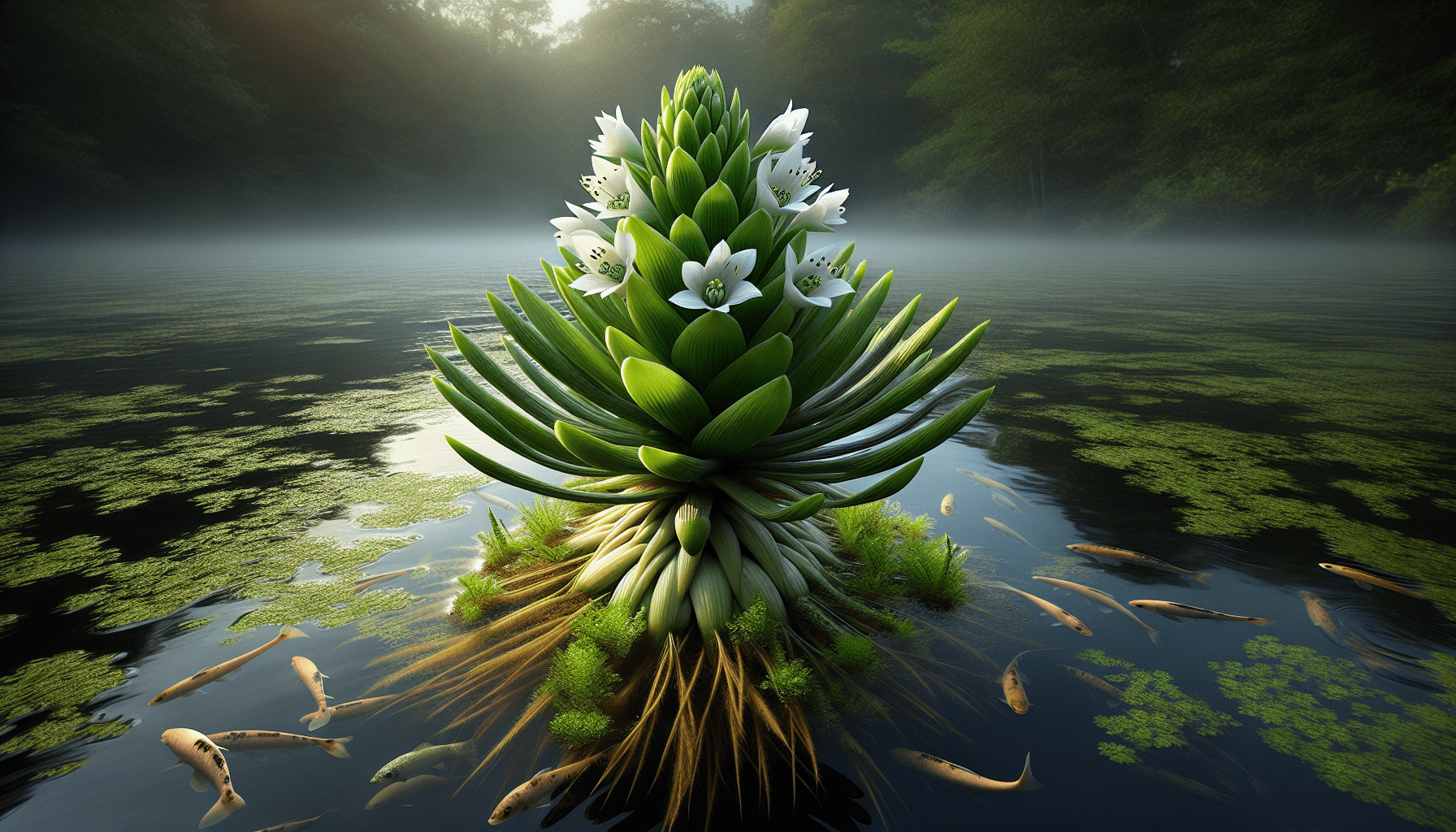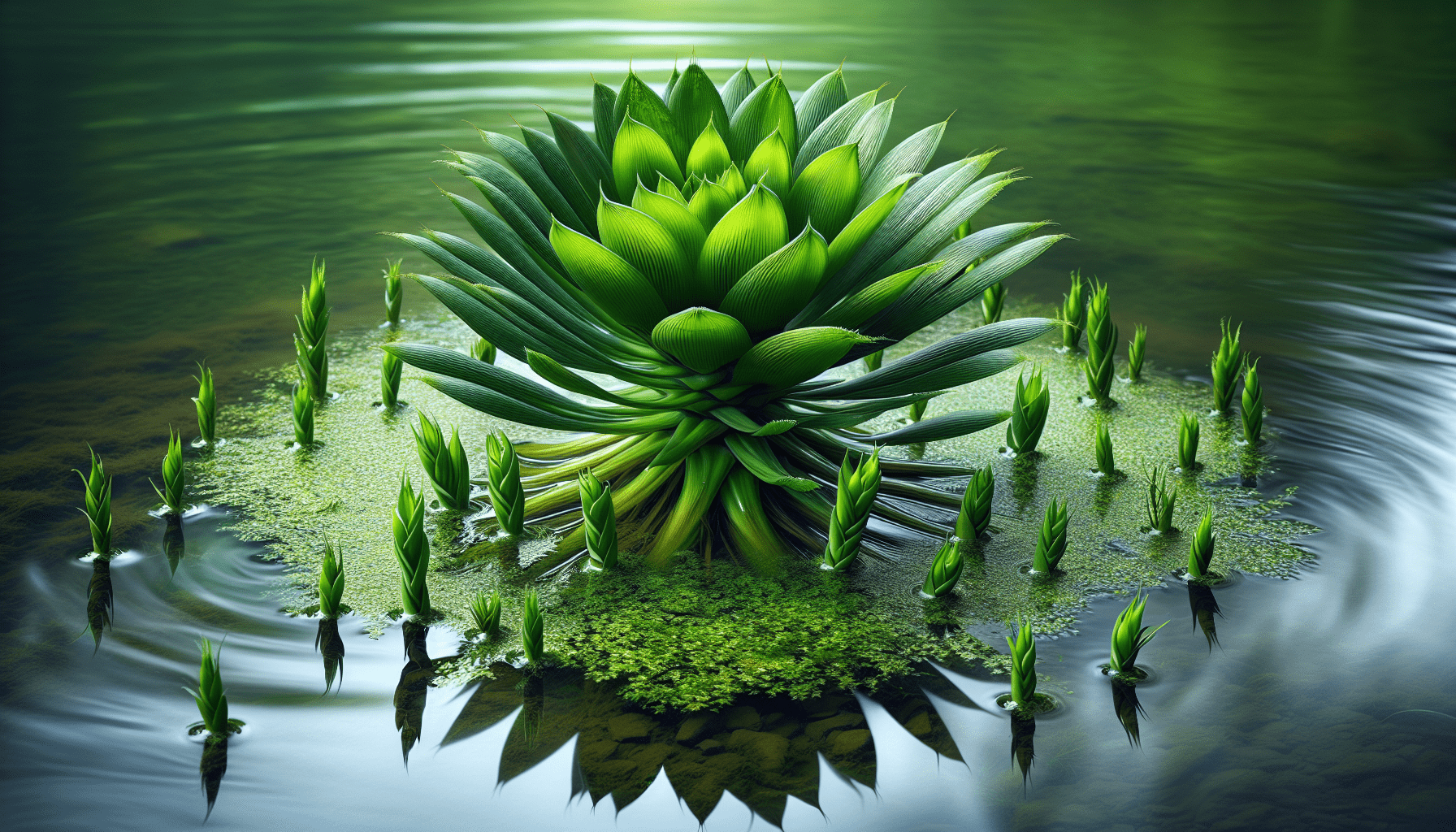Engaging in an exploration of aquatic ecology, you will encounter a vast variety of water-dwelling plants. Among these, the aquatic weed Stratiotes aloides, also referred to as Water Soldier or Water Pineapple, holds distinct significance. This article provides an elucidation of this unique species, shedding light on its characteristics, habitat, propagation, and its interaction with the ecosystem. As you venture into this thorough investigation, you will deepen your comprehension of this interesting and less commonly understood element of the aquatic environment.

Botanical Description of Stratiotes Aloides
When exploring nature’s wonders underwater, one cannot miss coming across a fascinating aquatic plant, Stratiotes aloides, also commonly referred to as water soldiers.
Physical Attributes
Stratiotes aloides are floating perennials with numerous sharp spiny leaves forming a rosette. The plant’s rosette averages a diameter of thirty centimeters, while the leaves, dull green in color, stretch sixteen to forty-five centimeters in length. This unique morphology gives the plant a resemblance to an open pineapple, making it easily identifiable. Their physical makeup allows them to resist damage and decay and remain buoyant even during winter months, truly a marine warrior.
Growth Patterns
The growth pattern of this plant is worth noting. They grow submerged in water during the winter, rising to the surface of the water in the summer. As the winter months approach, the plant descends back into the water, ensuring its survival despite the cold conditions, thus exhibiting a fascinating display of adaptation and resilience.
Flowering Characteristics
Flowering happens between June to August, depending on the region. The pure white flowers are unisexual, with separate male and female plants growing as separate entities. This characteristic makes reproduction an intriguing aspect of Stratiotes aloides, which will be delved deeply into later on.
Origin and Distribution
Historical Origination
Historically, Stratiotes aloides is believed to have originated in Europe and Asia. The plant was documented in the British Isles in the 16th century, and it has then since proliferated across much of Europe and parts of Asia.
Current Global Spread
Presently, the plant has an expansive geographical spread. Though it is primarily native to Europe, it has successfully colonized parts of North America and Asia. This colonization can be attributed to the plant’s highly efficient reproductive strategies and its robust adaptation to a wide range of water bodies.
Habitats and Conditions
Stratiotes aloides prefers eutrophic waters, including ponds, lakes, and slow-flowing rivers. It thrives in both soft and hard water conditions. It prefers acidic to neutral pH levels, but it can also tolerate slightly alkaline waters.
Common Names
Local Names
Different regions have different local names for Stratiotes aloides. In the United Kingdom, they are often referred to as ‘water soldiers’ or ‘water pineapple’. In other places, due to its spikey characteristics, they are known as ‘crab’s claw’.
Scientific Nomenclature
The plant is scientifically classified under the Hydrocharitaceae family. Its genus Stratiotes, meaning ‘soldier’ in ancient Greek, and the species name ‘Aloides’ cements its association with Aloe plants due to the similar physical appearances.
Slang and Colloquial Terminology
In everyday parlance, they are often referred to as ‘spiky floaters’ due to their physical attributes. The aquatic plant also has several colloquial names due to its aggressive nature in certain environments.

Ecological Impact
Effects on Local Ecosystems
Water soldiers, although occasionally used as ornamental plants in artificial water bodies, can become problematic in natural ecosystems. Their thick rosettes can form large stands that block sunlight from reaching submerged plants, and reduce the availability of oxygen for other aquatic organisms.
Biodiversity Impact
These plants, in high concentrations, are likely to modify natural habitats, potentially leading to reduced biodiversity. They may outcompete native flora for resources such as light, space, and nutrients.
Influence on Water Bodies
Moreover, their presence has been noted to sometimes alters the physical and chemical characteristics of waters, influencing the pH, turbidity, and nutrient concentration of the environment. Consequently, the water body’s overall ability to support aquatic life may also differ.
Economic Impact
Impact on Fisheries
One of the key sectors that Stratiotes aloides affects economically is Fisheries. Dense infestations can impede recreational activities such as angling and boating, leading to economic losses for local tourism and fishing industries.
Effect on Water-based Businesses
In addition to fisheries, the plant can have detrimental effects on businesses that depend on water bodies for their operations. For example, the plant can block waterways, which will pose a significant challenge to organizations operating barges and other water-bound transport—causing economic strain due to delayed transport and increased maintenance costs.
Cost of Control and Eradication
Furthermore, immense costs may be incurred in the control and eradication of Stratiotes aloides, especially in regions where it becomes invasive. These interventions may include mechanical, chemical, and biological methods, each bearing its own costs, benefits, and potential implications.
Cultural Significance
Use in Folk Medicine
Traditionally, water soldiers have been used in folk medicine, particularly in Europe. The plant was used to treat scurvy due to its high vitamin C content. It was also used to provide relief from rheumatism, wounds, and skin infections.
Symbolic Representations
The resilience and survival strategy of Stratiotes aloides have garnered it symbolic representations in various cultures. People have alluded to its qualities to symbolize determination, adaptation, and resilience in the face of adversity, much like soldiers.
Inclusion in Local Lore and Mythology
In several communities, particularly in regions where it is endemic, Stratiotes aloides features in local lore and mythology. In these narratives, the semi-floating plant often symbolizes the connection between different realms, such as the living and the spiritual, or the terrestrial and the aquatic.
Control and Management
Physical Control Methods
Because of their potential to become invasive, there are several control methods for Stratiotes aloides. Physical methods include manual or mechanical removal. This involves using hand tools or machinery to uproot the plants from the water bodies.
Chemical Control Methods
Chemical methods can also be employed. This generally involves the application of approved herbicides. However, chemical control should be used with caution due to the potential effects of chemicals on non-target organisms and water quality.
Biological Control Methods
Biological control is another approach, which entails the introduction of a natural enemy of the plant, such as an insect or fungus known to feed on it. This method requires carefully conducted studies to ensure that the control agent won’t become problematic itself.
Propagation and Growth
Reproductive Mechanisms
Stratiotes aloides have a unique ability to reproduce both sexually and vegetatively. They often adapt their reproductive strategy based on environmental factors. This polyvalent reproduction aids in their widespread distribution and colonization of various waters.
Growth Rate
The plant displays prolific growth and can create dense stands in a relatively short period. This rapid growth rate, combined with its reproductive ability, aids in the plant’s invasive trait, especially where it lacks natural predators or competitors.
Life Cycle
The life cycle of the water soldier is a perennial cycle. The plant begins growing submerged in winter, floating with flower buds in early summer, flowers and fruits in late summer, and then recedes underwater in late autumn.
Legal Status and Regulations
Legal Status in Various Countries
Due to its invasive nature, Stratiotes aloides’ legal status varies significantly in different countries. In some regions, it’s classified as an invasive species, while in others, it is protected as an endangered plant.
Import and Export Regulations
Due to the impact, the plant can have on local ecosystems, import or export between countries or states often has strict regulations. Breaching these regulations is often seen as a serious offense, potentially leading to considerable penalties.
Penalties and Fines
Penalties and fines for the illegal trading or distribution of Stratiotes aloides can be substantial. They serve as stringent measures to prevent the plant’s potential spread to new water bodies, thereby curbing its ecological impact.
Future Considerations
Potential for Invasive Spread
The plant’s potential for invasion needs to be considered due to its potent reproductive capabilities and aggressive growth habit. Enhanced monitoring systems, as well as public education on the plant’s impact, can go a long way in managing its spread.
Implications for Climate Change
Environmental changes influenced by climate change, like changes in water temperature or nutrient load, may alter the proliferation rate and distribution of water soldiers. Some estimates suggest the plant potentially inhabiting more regions in the future as environmental conditions change.
Needed Research and Understanding
More research is needed to fully understand the ecological impacts and control methods for Stratiotes aloides. Collaboration between researchers, policymakers, and communities alike can help devise effective strategies to deal with and control this fascinating, albeit perennially challenging, plant.